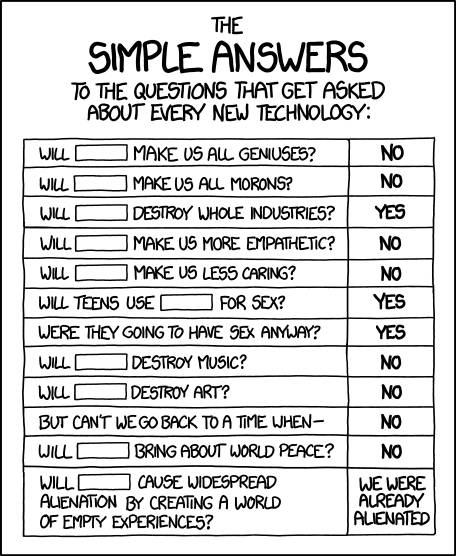I
should say, in the interest of full disclosure, that I was skeptical of
Rushkoff right off the bat. Program or be
Programmed? It’s the ultimatum that really gets me. As a casual reader
looking for a hook, I admit that I love his style. It’s blatant and
provocative, and undoubtedly interesting. I’m being taken advantage of by the
elite? “They” don’t want me to understand how my devices work? Insomuch that Rushkoff
works to put programming on a pedestal , trying to make seem like necessary
civil disobedience, I think he succeeds.
As
a critical thinker, however, I’m less sure. By the end of things, I feel a bit
chilled, and not for the right reasons; I feel as though I’ve been run
roughshod over and vaguely insulted; I think that some credit where credit is
due is lacking left and right.
I
can’t help but think, at the end of this semester of reading, that we as
scholars and as access activists, can do better than this. In a discipline
where much of the fascination lies in the in-between spaces, the up-against and
the puzzles, I simply reject the notion that there are two rigidly defined
choices and nothing else. Near the beginning of the introduction, Rushkoff
says, “In the emerging, highly programmed landscape ahead, you will either
create the software or you will be the software. It’s really that simple:
Program, or be programmed. Choose the former, and you gain access to the
control panel of civilization. Choose the latter, and it could be the last real
choice you get to make” (7-8). He’s very concerned, all along, about the elite
that controls the dominant medium of the age, and I can’t fault him for that.
Media is obviously controlled by people
with powerful hands. However, I think that if the discussion turns into a
simple David vs. Goliath power struggle, that it will end in reduction. As far
as I’m concerned, program or be
programmed is the kind of attitude that will create an elite/powerless
dynamic just as much as the programmer vs. end user juxtaposition that Rushkoff
sees happening now. That type of better-than-thou attitude is one of the things
that I think turns people off from
wanting to understand the technology they’re using. It’s not productive with
casual users, and I don’t even think it’s productive amongst an academic
audience. If we’re truly interested in the spread of thoughtful and powerful
digital tools, the worst thing to do is to force them.
I
struggle with this, because there are aspects of Rushkoff’s writing that I think
are really valuable. He’s certainly not wrong about the potential power of
programming, and I wouldn’t try to deny that media has long been harnessed most
effectively by those with the money and the influence. I appreciate his
appreciation of the “value-creation” potential of technology. Personally, I
think there’s great value in programming, and I hope that I can continue to
pick up skills that will allow my digital work to evolve.
It’s
just the rigidness that I can’t allow. Is anything so black and white? What does
making this type of argument even get you? People that agree, would have agreed
anyway, and people that are on the fence, like me, are apt to find things to
question—like me—and feel less friendly to the cause than they did before they
started reading.
And
since I’m questioning things, let me add one more thing. Rushkoff says that we’ve
at least, as a society, gotten to the point of writing. We write while the
elite program. The point I think he misses, though, is that writing in a
digital age is not at all the same as writing in any previous age. If I have learned
anything this semester, it is that our communicative actions are deeply tied to
their forms. A question that needs to be asked, I think, is what is it to write in an age of
programming? What aspects of programming can we become aware of; how can
the technology inform our writing strategies? To put all of our academic and
social eggs in the basket of programming just seems short-sighted, and it
devalues the other meaningful work that’s being done, sometimes work that is “just”
being done using the programs already at our disposal.
